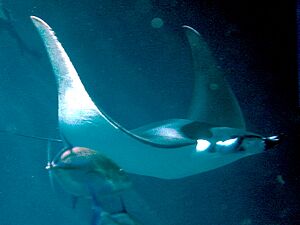Spinetail mobula ray facts for kids
Quick facts for kids Spinetail mobula ray |
|
|---|---|
 |
|
| Exhibited individuals at Osaka Aquarium | |
| Conservation status | |
| Scientific classification | |
| Genus: |
Mobula
|
| Species: |
japanica
|
| Synonyms | |
|
|
The spinetail devil ray (Mobula japanica) is a large ray that lives in the ocean. It is also known as the spinetail mobula ray or Japanese mobula ray. This amazing species of marine fish belongs to the family called Mobulidae. You can find it in warm, tropical, and sub-tropical waters. It lives in the Indo-Pacific region and the eastern Atlantic Ocean.
Contents
About the Spinetail Devil Ray
The spinetail mobula ray is a very big ray. It can grow up to 3.1 m (10 ft) wide. That's about as wide as a small car! On average, they are about 2.3 m (7 ft 7 in) wide.
Like most rays, its body is flat from top to bottom. It has two large, triangle-shaped fins on its sides. These are called pectoral fins. At the front of its head, it has two special fins called cephalic fins. These fins are extensions of its pectoral fins.
These cephalic fins can roll up into a spiral when the ray swims. But when it's time to eat, the ray can spread them out. This helps to guide water and food into its mouth, which is on its belly.
The top of the ray's body is a deep blue-purple color. It has a big black band that goes from one eye to the other. Its underside is white. The inside of its cephalic fins are silver-grey with black tips. The outside of these fins and the area behind its eyes are white.
You can tell this ray apart from other large rays by a few things. It has a head that sticks out. Its dorsal fin (the fin on its back) has a white tip. It also has a spine located between its dorsal fin and the start of its tail. Its tail is also quite long. The ray's spiracle, which is a breathing hole, is right above where its pectoral fin meets its body.
Where They Live
We don't know a lot about exactly where these rays live. But scientists believe they live all over the world in tropical and temperate waters. They can be found close to shore, further out in the ocean, and even in the open ocean. The southern Gulf of California seems to be a very important place for them. Rays go there to mate and have their babies.
Reproduction and Life Cycle
The spinetail mobula ray lives a pelagic lifestyle. This means it lives in the open ocean, not near the bottom. You might see them swimming alone or in groups. They eat tiny sea creatures called zooplankton. They do this by filtering seawater through their mouths.
Like all rays in the Mobulidae family, the spinetail devil ray gives birth to live young. This is called ovoviviparous. After the ray mates, the fertilized eggs grow inside the mother's body. At first, the eggs are in a special egg case. The baby ray inside gets food from a yolk, just like a chicken egg.
Once the egg hatches, the baby ray stays inside the mother. It gets special milky food from her. When the baby ray is born, it is already quite big! It measures about 70 to 85 centimeters wide.
Conservation Status
Sadly, the spinetail mobula ray is in danger. In recent years, people have been fishing for these rays more and more. This is because their gill rakers (parts inside their gills) are valuable. They are used in traditional Chinese medicine.
Besides being caught on purpose, these rays also get caught by accident. This often happens in fishing nets, especially gillnets. These rays don't have many babies, and it takes a long time for them to grow up. They only have one baby at a time after a long pregnancy. Because of this, losing even a few rays has a big impact on their numbers.
Because of these reasons, the spinetail mobula ray is now classified as Endangered by the IUCN. This means they are at a very high risk of disappearing forever.
Threats to Spinetail Devil Rays
The spinetail devil ray faces many threats. They are caught both on purpose and by accident in different types of fishing. Even though people are trying to protect them, more and more of these rays are being caught. This is because there is a high demand for their gill plates.
Also, their homes in the ocean are being destroyed. Pollution in the ocean also harms them. These problems make it even harder for these amazing rays to survive.


